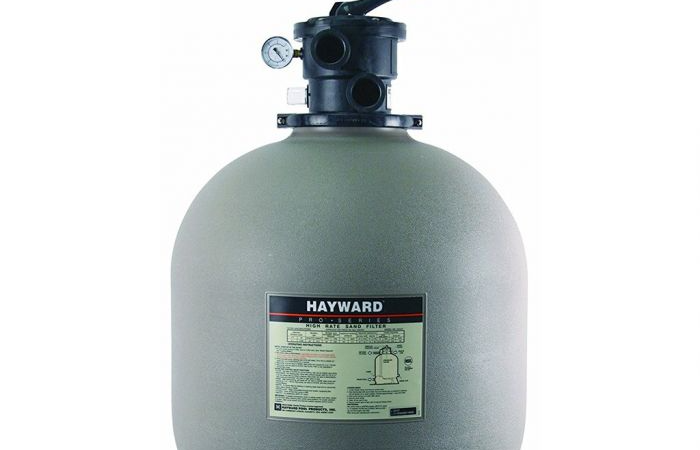- Home
- Maintenance
- Pool Sand Filter Maintenance
Swimming Pool Sand Filter Maintenance
If you've ever wondered what type of pool filter should you get, you probably have looked at a sand filter. Although it might seem a bit strange, sand is actually very good at filtering your pool water. Sand is also the oldest form filtration and it goes back for centuries. Everything needs occasional maintenance from time to time, and your pool sand filter is no exception.
We'll go over your typical swimming pool sand filter maintenance needs, and we'll cover the most common problems that might occur with your sand filter.
What Is A Pool Sand Filter
Our cars need maintenance. So do our houses, relationships, health, and our lives. Let's not leave out our sand filters!! Pool sand filters are known for being a good filtration system and one that's affordable. A sand filter works by filtering your pool water through the top of the sand, similar to an espresso machine.
By force, the water is pressed through the sand. What's left behind is the dirt and debris from the water. The clean water is then returned back to the pool through the returns found in the pool. Sand filters are so efficient that they're used for drinking water.

Why Does My Pool Sand Filter Need Maintenance?
Over time, this dirt and debris accumulates in the sand and reduces water flow. The filtration property and capacity decreases. This reduction in water flow causes the pressure to increase inside the filter.
When this happens, it's time to backwash your filter to remove the excess dirt and debris. To stay on target, pool sand filter maintenance requires backwashing when needed.
When Should I Change The Sand In My Pool Filter?
Another area to keep in mind is changing your sand when your sand filter requires. While this only needs to be done every so often, it's important to know some reasons why your pool sand might need to be changed such as:
- Cloudy water.
- Pool water that doesn't seem to clear up.
- Poor filtration.
- Long backwashing cycles.
- Sand returning to the pool.
- Reduced filtration.
- Pressure issues.
It's important to check the condition of your sand every 5 - 7 years and decide if it needs changing.
Change Pool Sand Filter Laterals
The laterals in your sand filter look like "fingers" that radiate out from the bottom of the standpipe pipe. This pipe runs down through the middle of the filter and each lateral is removable and replaceable.
On some models, if one lateral is broken or damaged, the entire unity must be replaced. When replacing the sand, it's important to visually inspect each lateral for any broken or cracked areas. If you find a lateral that is broken, you'll need to replace it. Broken laterals are the main cause of sand going back into the pool during the filter process. Once the visual inspection of the laterals is complete, you can proceed with the rest of the process of filling your tank with new sand.
Sand Filter Multiport Valve
Sand pool filters will have what is known as a “Multiport Valve” or MPV. This valve is an all-in-one valve that makes your pool life a little easier. If you're not familiar with a Multiport valve please read the following and/or consult your owner's manual concerning your sand pool filter maintenance.
If your swimming pool motor (pump motor) is on and you decide to start turning any valves, that could cause all kinds pool filter problems. Be sure the filter pump motor is off before turning anything.
Pool Sand Filter Multiport Valve Settings
The multi-port valve (MPV) settings on this type of valve are as follows:
1. Filter
This is the normal setting for the valve. The pool water is drawn by the pump motor, passed through the filter, and is then returned back to the pool as clean water.
2. Backwash
This setting is used to flush out the filter when the sand filter media becomes overloaded with dirt and debris. Water is drawn from the pool, is passed through the filter sand and then exits out of the filter as dirty water. A high pressure sand filter reading means it's time to backwash.
3. Rinse
This setting is used to flush out any dirt, debris, or excess pool filter sand that may remain in the lines after backwashing, and only requires about 10 seconds. This water exits as waste and not back into the pool.
4. Recirculate
This function allows for the pool water to circulate without passing through the swimming pool filter sand again. This setting is used when chemicals need to be mixed in the pool.
5. Waste
This setting runs water from the pool directly to the drain or backwash hose, and can be used when lowering the water level, when certain adjustments are needed, or when vacuuming large amounts of dirt.
6. Closed
This setting is to be used ONLY when the pump motor is off. Closing this valve while the pump is running could seriously damage your sand filter. You will want to use the closed setting only when:
- Performing any swimming pool sand filter maintenance.
- Replacing pool filter sand.
- Changing sand in pool filter.
- Making any repairs to the sand filter parts.
- Cleaning the filter unit or filter basket.
If you have any questions or are not sure about the multiport valve or any part of your pool sand filter, check with your local pool store or find a qualified pool technician.
About Your Sand Filter Multiport Valve
Words are used such as "filter" and "circulate" as in "make sure you circulate your water" or "circulation is the key to clear water". When you hear the words "filter" and "circulate" you must know they mean different things, have different definitions, and different applications.
FILTER means the water is being pressed through the sand and clean water is being returned back to the pool. CIRCULATE means the water has bypassed the filter altogether and is returned back to the pool. It can also mean the returns are mixing up the water as in the case of pools that are equipped with hydro-jets.
We can have circulation without filtration but it is only in rare instances that we have filtration without circulation. On the MPV we have the settings FILTER and RECIRCULATE.
How To Backwash Your Pool Sand Filter
For proper care of your inground and above ground sand filter, and to keep your sand filter running at peak performance, you'll need to backwash your filter when the pool system calls for it. This is normally 8 - 10 psi over the "just backwashed" pressure. Go here for a more thorough description on how to backwash your sand filter.
- Raise the water level 1"-2" if it's low. Turn the pool filter system OFF and clean the pump basket. Remove any debris and carefully place the basket back into the filter pump housing and reattach the pump lid. Remember to check the gasket or O-ring. If it's torn or broken you'll need to replace it.
- Roll out your backwash hose, if applicable, and turn the filter control valve to BACKWASH.
- Turn the filter pump back ON and pump out dirty water until the water runs CLEAR through the hose and/or site glass, then turn the pump OFF.
- Set the control valve to RINSE and turn the pump on for about 10 seconds. Turn off the pump. This will get rid of any loose debris or pool filter media that may be in the lines or pool filter system.
- Turn valve back to FILTER and you're done.
Top 5 Pool Sand Filter Troubleshooting Solutions
Your swimming pool sand filter is an important piece of equipment and is needed to keep your water clean and clear. Just like your pool water, your sand filter needs occasional maintenance, but not as often.
All sand pool filter problems need to be fixed quickly to prevent algae growth. In this list, we'll look at some common sand pool filter problems, what look look for, and how to fix them.
1. Leaking Multiport Valve
The multiport valve isn’t a direct part of the sand filter tank, but it’s an important part of your filtration system and should checked. The multiport valve is going to be attached to the sand filter on the side or on the top of the filter tank. The spider gasket is located inside of the multiport valve and is responsible for keeping the flow of water through the correct ports.
Problems with the gasket can occur due being worn down, or simply age. It can also come out of its track, become, loose, or even twisted. When this happens, water is forced through other ports and creates issues with leaking. Your filter won’t function as it should and your pool water can become cloudy. The spider gasket will need to be replaced.
2. Broken or Bad Laterals
We briefly touched on this, but let's circle back around once again. When the laterals in the sand filter are broken, the sand returns to the pool, and the lateral will need to be changed. Changing the lateral is the easy part. The hardest part is removing the sand filter media to get to it.
3. Dirty Sand Filter
If your backwashing cycles have become shorter, or you've noticed your water is not as crisp and clean as it once was, your sand filter might be too dirty or greasy. When this happens, the water can't properly flow through the sand filter media. The water is forced to create a channel down the side of the filter and then returns this unfiltered water back to the pool.
A sand filter cleaner can help with this, but for a more permanent fix, you should replace the pool filter sand.
4. Filter Pressure
During the filter process, you'll want to check the pressure to ensure it’s in the correct range. A filter that’s too small for the pump can cause a build-up of pressure inside the tank. Your pump motor is trying to push the same amount of water through a smaller area, which will cause the pressure to rise in your sand filter tank.
This pressure could also be an indication of a dirty filter that needs to be backwashed and rinsed.
Low pressure in your sand filter is also an issue. If your sand filter has low pressure, make sure the suction side of the system is clear and the water level is correct. Correction of these issues will ensure the pressure goes back to normal.
5. Tank Failure
Sand filter tanks are under a tremendous amount of pressure. A rupture can happen when the valves are closed, or if the multiport valve is closed, but the pool pump is still on. This is an extremely dangerous situation and should be dealt with using caution.
You want to keep an eye on the pressure gauge when you turn the pump on. If pressure begins to rise too quickly, or rises too high, then you should turn the pump off as fast as possible.
Check for closed valves and open the ones that need to be opened for proper water circulation.
Become A Swimming Pool Sand Filter Maintenance Pro
Before getting started with your swimming pool sand filter maintenance, be sure to check the owner’s manual or go online. Most pool problems are easy to fix, but some manufacturers might void any warranties if service is not performed by a qualified pool contractor.
Regardless, pool sand filter maintenance and repairs should be taken care of as soon as possible to keep your pool water clean and safe. You can do your part by maintaining the right chlorine and pH levels, removing debris on a daily basis, and making sure your pool filter is working for optimum efficiency.
What Other Visitors Have Said
Click below to see contributions from other visitors to this page...
Low Water Pressure From The Return 




I changed the sand in my filter for the first time, after having the pool and filter installed 8 years ago.
The local pool store demonstrated how to …
No Water Flow Through Glass Sight Gauge On My Filter System 




Under normal operation there is no water flow thru the glass sight gauge on my filter system. When I backwash I get the flow. When I place it back to filter …
Why Is Water In My Backwash Hose Filling Up Not rated yet
My husband backwashed sat.and left the hose rolled out into the yard. We noticed on the way to church Sunday but forgot to put it up when we got home. …
Repair Hayward S200 Sand Tank Not rated yet
I have replaced the o'ring in my Hayward S200 sand filter and now it leaks around the middle of the tank where it opens. I have the one that is connected …

